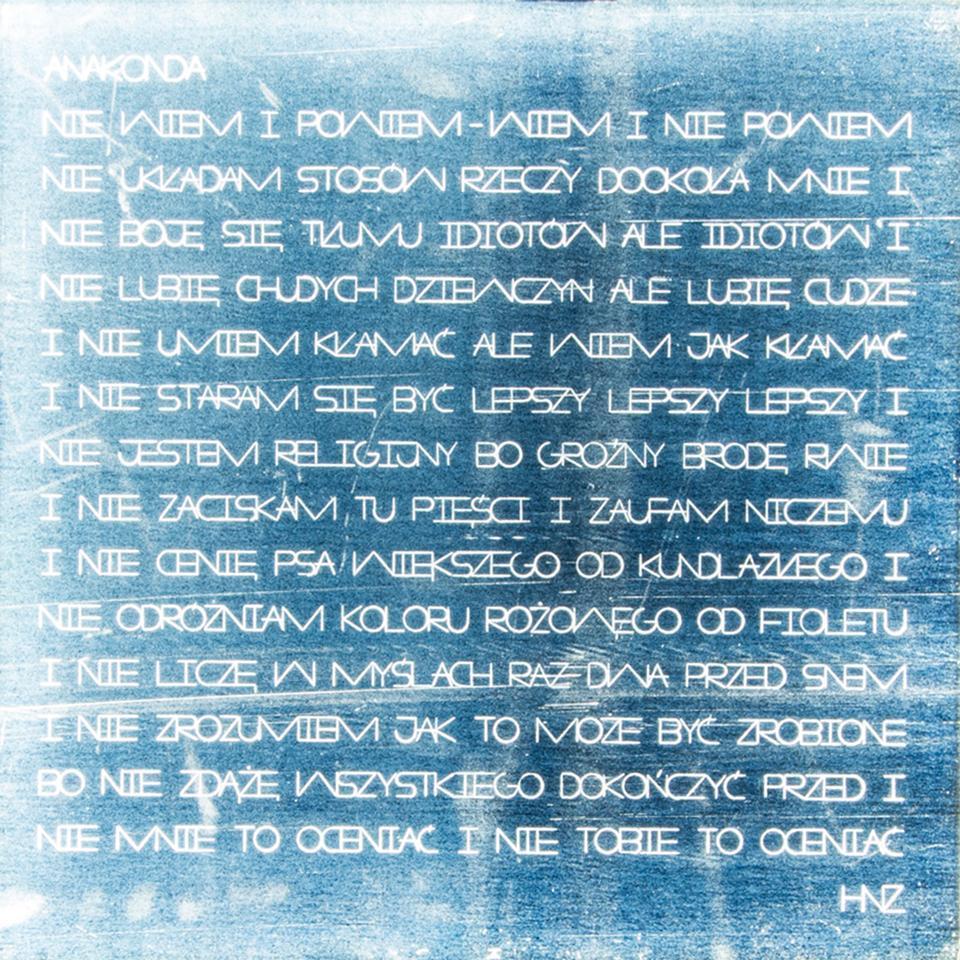Honza Zamojski
Anaconda
Honza Zamojski
Anaconda, 2012, 50 × 50 cm, light box, drawing on carbon paper
Collection II of the Arsenal Gallery in Białystok. Work donated to the Arsenal Gallery by the artist

The text which Honza Zamojski wrote on carbon paper accompanied a cycle of drawings presented during his solo exhibition in Galeria Arsenał in Białystok in 2012. The background to the stream of words was a set of visual notes on thoughts and images that came to the artist’s mind in connection with the process of creating art. Yet Zamojski’s reflections in drawing refer not only to the artist himself, but also to all factors and persons by which he is constituted. Thus, these drawings tell of art criticism, art history and its methodologies, the questions artists and works of art tend to be asked, and, ultimately, the answers to those questions.
Zamojski wrote and drew on paper. But in the case of his actions, the proper medium for a work was carbon paper – a ‘mediating paper’, always treated in a purely utilitarian manner. It is an even more intriguing medium considering that its status is ambiguous, situated between an original and a copy. The tradition of graphic art might recommend comparing carbon paper to the plate onto which a drawing is transferred in order to be printed on paper or some other material. This, however, would be a fallacious comparison, since that first drawing is never really treated as an original of which the resulting print is only a copy. This very approach to carbon paper is already a transgression, an intrusion into the relationship between the copy and the original – a relationship which is, after all, crucial to art history, and especially to art market.
Drawings exhibited together with the poem showed, among others, emoji that are an element of the smartphone culture, schematic sketches resembling those in technical lettering manuals, squiggles and emotional notes, as well as references to canonical works of art such as Rembrandt van Rijn’s Self-portrait (1659) or Jan Matejko’s Stańczyk (1862). In addition, many of the sketches show the figure of Pinocchio, which references literary and fairy-tale motifs and psychological themes. Zamojski visualises everything that an artist’s mind may contain and which is often enquired about by art critics and art historians: influences, inspirations, techniques, conceptions and meanings of his works. He leaves his critics and recipients with the poem: “[…] I DON’T LIKE SKINNY GIRLS BUT I LIKE OTHER MEN’S GIRLS / AND I AM NOT GOOD AT LYING BUT I KNOW HOW TO LIE / […] AND I WILL NOT UNDERSTAND HOW IT CAN BE DONE / BECAUSE I WILL NOT MANAGE TO FINISH EVERYTHING BEFORE AND / IT IS NOT FOR ME TO JUDGE AND IT IS NOT FOR YOU TO JUDGE”. Things that pertain to creativity are embedded in the recesses of memory, in the drawers of the subconscious, in the cultural baggage. It is not impossible that the artist himself perceives all this as a chaos, on which some order is imparted by solitary creative gestures.
Izabela Kopania
translated from Polish by Klaudyna Michałowicz

PLAN YOUR VISIT
Opening times:
Thuesday – Sunday
10:00-18:00
Last admission
to exhibition is at:
17.30